Japan
Wood Products Prices
Dollar Exchange Rates of 15th
Apr
2025
Japan Yen 143.52
Reports From Japan
Tariffs could inflict serious blow to Japanese
industries
The combination of additional automobile tariffs and the
reciprocal tariffs imposed by the US could inflict a serious
blow to Japanese industries. Japanese companies are
scrambling to discuss measures against the tariffs but
handling the situation will not be easy as reviewing
production systems is not a simple task.
Ken Kobayashi, chairman of the Japan Chamber of
Commerce and Industry, expressed strong concerns over
the additional 25% tariffs imposed on automobiles. “The
automobile industry is underpinned by wide reaching
supply chains. I am concerned that (the additional tariffs)
will have an enormous impact on the Japanese economy as
a whole through decreases in orders, investment and
employment,” he said.
The automobile industry employs 5.5 million people in
Japan, which also includes such firms as parts companies,
so there are concerns that the tariffs will have impact on
related industries.
The tariffs cover a wide range of items, including
construction machinery and agricultural, forestry and
fishery products, with exemptions placed on such items as
pharmaceutical products and semiconductors. The
Japanese government plans to increase exports of
agricultural, forestry and fishery products and food to 5
trillion yen in 2030 but the target will be difficult to
achieve if exports to the United States slow down.
See:
https://japannews.yomiuri.co.jp/business/companies/20250404-
246973/
Soaring prices keeps ‘real’ wages on the decline
Japan's inflation-adjusted wages fell for the second month
in February as price increases outweighed pay raises. The
Ministry of Labour data show that real wages were down
1.2% from the same month last year. Officials noted that
soaring prices kept real wages on the decline.
Workers in February earned an average of 289,562 yen,
including base pay and overtime. That's up 3.1% year on
year in yen terms and marks an increase for the 38th
month in a row.
See: https://www3.nhk.or.jp/nhkworld/en/news/20250407_B4/
Government to offer aid to Japan-based exporters
The Ministry of Trade has indicated it plans to offer aid to
Japan-based exporters amid concern that US tariffs will
hurt their business. The ministry set up a task force to
implement easier loan terms and develop other policies to
help affected exporters.
Loans to struggling businesses will be offered with easier
requirements under the Ministry plan. State-run financial
institutions such as Japan Finance Corporation will
provide the lending. The ministry also plans to set up
about 1,000 inquiry counters across Japan including at its
bureaus and state-run financial institutions.
The Minister of Trade, Muto Yoji, reiterated that the
government continues to seek an exemption from the new
tariffs and will work to protect industries.
See: https://www3.nhk.or.jp/nhkworld/en/news/20250404_B1/
Bank of Japan welcomes strengthening of the yen
New US tariffs may delay but not halt the Bank of Japan's
plan to raise interest rates further as policymakers seek to
avoid renewed yen falls that would worsen inflationary
pressures.
The US decision to impose a 25% levy on auto imports
and a reciprocal 24% tariff on other Japanese goods, will
deal a huge blow to the export-heavy economy with
analysts predicting the higher duties could knock up to
0.8% off economic growth.
See: https://www.reuters.com/markets/rates-bonds/trump-tariffs-
may-delay-wont-derail-japan-rate-hikes-2025-04-04/
Households cut back on spending
In February Japanese households cut back on spending as
inflation remained high. The Ministry of Internal Affairs
reported household outlays, adjusted for inflation, declined
0.5% in February from a year earlier.

Consumer spending accounts for more than a half of the
economy and is a key component of GDP that is
monitored closely by Bank of Japan. Inflation has stayed
at or above the BoJ’s target for almost three years, sapping
spending power and the latest tariffs from the United
States are now expected to weaken the economy further.
Calls are growing in Japan for a major economic stimulus
package that includes adjustments to the consumption tax
cut in order to cushion any negative impact to the Japanese
economy from US tariffs.
With food prices still rising even ruling party officials
have started to discuss a consumption tax cut as a key
policy especially in light of the upcoming election for the
the upper chamber of the country's parliament.
See:
https://www.japantimes.co.jp/news/2025/04/06/japan/politics/co
nsumption-tax-cut/
Yen at strongest level in six months
Concern over a global economic slowdown from wide-
ranging US reciprocal tariffs led to a rapid appreciation of
the yen in md April. The yen appreciated to the mid-145
range against the dollar mid month taking Japan's currency
to its strongest level in about six months on concerns
about a US economic slowdown.

The world's largest wooden structure
Expo 2025 Osaka, Kansai, Japan will run 13 April to 13
October. The six month event is being held in Yumeshima
(Konohana Ward, Osaka). The ‘Grand Ring’, a wooden
structure, symbolises this Expo’s theme, ‘Designing
Future Society for Our Lives,’ and has attracted
considerable attention.
This massive, ring-shaped structure with a circumference
of about two kilometres covers an area of approximately
60,000 square metres and stands between 12 and 22
metres in height. Such a large-scale structure made of
wood has generated significant interest.
The centerpiece of the 2025 Expo, the Grand Ring, has
been recognised by Guinness World Records as the
world's largest wooden structure. Sou Fujimoto, the
architect responsible for the design of the Grand Ring and
the Expo Site Design Producer, commented “when
creating the overall concept for the Expo site, we proposed
and developed the theme of ‘Unity in diversity’ while
designing the venue.
See: https://www.gov-
online.go.jp/hlj/en/february_2025/february_2025-05.html
and
https://www.expo2025.or.jp/en/news/news-20250304-02/
Tighter of overtime rules drive up contruction costs
regulations
According to the Real Estate Economic Institute the
national average price of newly built condominiums in
2024 was 60.82 million yen (approx. US$405,000),
topping 60 million yen for the first time since statistics
began in 1973. Prices have risen for eight consecutive
years.
One factor behind the price increases is surging
construction costs. Along with material prices remaining
high, the "2024 problem," referring to the strengthening of
overtime regulations in the construction industry, has
exacerbated labour shortages and labour costs are expected
to continue to climb.
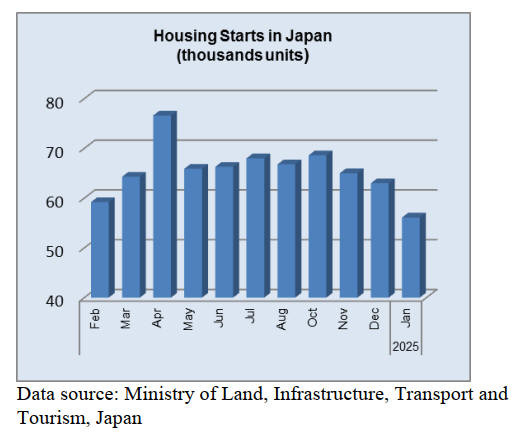
The Japan Residential Property Price Index (set at 100 in
2010), which indicates national real estate price trends,
shows that both condominiums and detached homes have
been rising in price in recent years but that the increase in
condominiums is more pronounced.
Positive assessment of regional economies
In mid-April the Bank of Japan (BoJ) maintained its
economic assessments for all nine regions of the country,
even as US tariffs are threatening to impact the economic
outlook.In its quarterly report on regional economies, the
BoJ said the nine regions were either "recovering
moderately," "picking up" or "picking up moderately
although some weakness had been seen in part," using the
same expressions as in the previous assessment in January.
The wide-ranging US tariffs will "put downward pressure"
on the Japanese and global economies, Bank of Japan
Governor Kazuo Ueda said Friday.
See:
https://www.boj.or.jp/en/research/brp/rer/data/rer250407.pdf
Import update
Assembled wooden flooring imports
The value of Japan’s January 2025 imports of assembled
wooden flooring HS441871-79 were over 60% higher than
in January 2024 and over 60% compared to December
2024. The last time the value of imports was so high was
in June 2022.
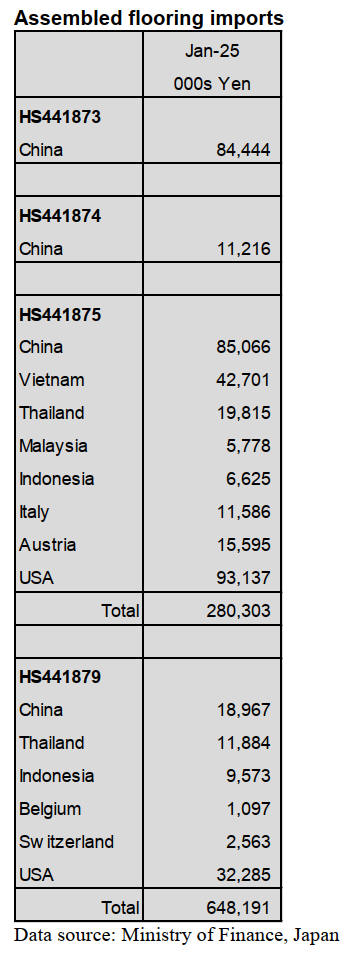
The main category of assembled flooring imports in
January 2025 was HS441875, accounting for 62% of the
total value of assembled flooring imports compared to the
59% share reported in December. Of HS441875 imports,
33% was provided by shippers in the US, 30% by shippers
in China and 9% by shippers in Vietnam. The sudden rise
in imports of HS441875 from the US taking to top spot in
terms of the value of imports was a surprise especially as
US deliveries exceeded those from China.
The three other sources of assembled flooring (HS441875)
in January were Thailand, Austria and Italy.
The second largest category in terms of value in January
2025 was HS441873 all of which was shipped from China.
In January HS441873 accounted for 19% of all HS441873
arrivals. The third largest category in value terms was
HS441879 (17%).
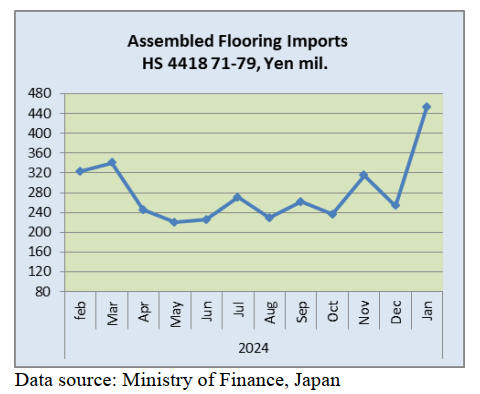
Plywood imports
The very quiet market for plywood in Japan in January
2025 was refleected in the volume of imports. Year on
year the volume of imports was down 12% and compared
to December there was little change. Malaysia and
Indonesia were, as usual, the top suppliers in January
2025. Arrivals from Malaysia were up slightly while
arrivals from Indonesia were at around the same volume as
in December 2024.
In January 2025 all the main shippers recorded a decline in
the volume of shipments except shippers in Vietnam were
the volmes in January were around the same level as in
December 2024. The volume of January 2025 plywood
imports (441210-39) was 121,161 cu.m.
As in previous months, of the various categories of
plywood imported in January 2025 HS441231 was the
largest (84% of total imports) followed by HS441233
(7%). Malaysia and Indonesia accounted for most of the
HS441231 arrivals in December.
Small volumes of HS441239 and HS441234 arrived in
Japan during January from a wide range of suppliers
including Latvia, Chile, the Philippines, Taiwan P.o.C and
New Zealand.
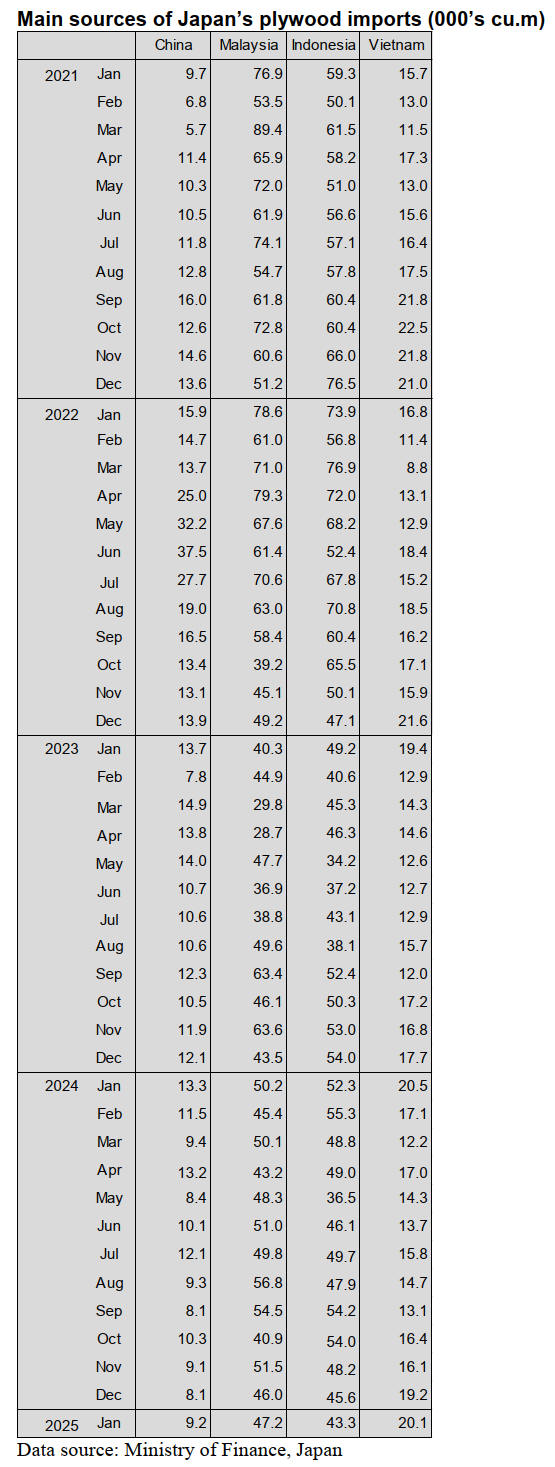
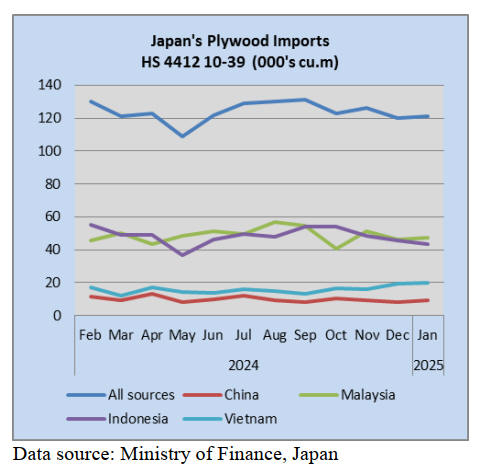
Trade news from the Japan Lumber Reports (JLR)
The Japan Lumber Reports (JLR), a subscription trade
journal published every two weeks in English, is
generously allowing the ITTO Tropical Timber Market
Report to reproduce news on the Japanese market
precisely as it appears in the JLR.
For the JLR report please see:
https://jfpj.jp/japan_lumber_reports/
Imported wood fuel in 2024
Import of wood pellet in 2024 is more than 2023 and of
PKS is less than last year. Total volume of wood pellet
and PKS is 8,814,103 tonnes, 1.4 % more than last year.
Volume of wooden pellet in 2024 is 638,931 tonnes, 10.0
% more than 2023 and it is 577,557 tonnes increased. The
reason for the increase is that the volume of South Asian
wooden pellet rises from the previous year.
Vietnamese wooden pellet is 3,315,260 tonnes, 27.4 %
more than last year. Canadian wooden pellet is 1,166,602
tonnes, 26.3 % less and American wooden pellet is
1,118,215 tonnes, 11.5 % less than 2023.
On the other hands, Malaysian wooden pellet is 403,069
tonnes, 74.7 % more, Indonesian wooden pellet is 314,895
tonnes, 372.9 % more and Thai wooden pellet is 35,077
tonnes, 349.2 % more than last year. Australian wooden
pellet is 23,961 tonnes, 51.3 % less than last year.
Total volume of PKS in 2024 is 2,433,172 tonnes, 15.7 %
less than 2023. Indonesian PKS is 1,876,999 tonnes, 16.0
% less and Malaysian PKS is 534,406 tonnes, 16.7 % less
than the previous year. However, Thai PKS is 21,767
tonnes, 108.7 % more than last year.
Revised Clean Wood Act
The revised Clean Wood Act will come into effect in
April, 2025. As illegal logging is being eradicated
worldwide, Japan has also been working on this issue. The
main change to the revised Clean Wood Act is that a
business person, who involves wood industry, will be
required to verify legality.
The current Clean Wood Act is that the forest business
owners are obligated to make efforts to cut down trees
legally. The third party organization registers the forest
business owners to use more legal woods.
Volume of composite wood flooring in 2024
The production and sales volume of composite wood
flooring in 2024 do not exceed the result of 2023. The
sales volume decreases for three years in a row. The
reasons are the low new starts and a decrease in floor
areas. The production is 4.4 % less and the sales volume is
5.7 % less than last year. The starts in 2024 are 3.4 % less
than 2023.
The production at the first half of 2024 is 6.8 % less and
the sales volume at the first half of 2024 is 7.7 % less than
the same period last year. However, demand for composite
wood flooring rose at the second half of 2024.
The production of LL45, which is the classification of
sound insulation, is 1,976,000 tsubo, 2.5 % more and the
sales volume is 1,997,000 tsubo, 1.5 % more than the
previous year. One of the reasons for the increase in LL45
production is that some building material companies had
market development of sound insulation for apartment
buildings through the COVID-19.
|